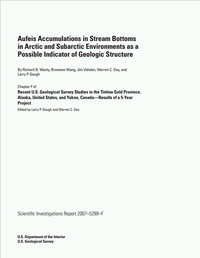Thick accumulations of ice, called “aufeis,” form during
winter along stream and river valleys in arctic and subarctic
regions. In high-gradient alpine streams, aufeis forms mostly
as a result of ground-water discharge into the stream channel.
The ice occludes this discharge, perturbing the steady-state
condition, and causing an incremental rise in the local water
table until discharge occurs higher on the stream bank above
the previously formed ice. Successive freezing of onlapping
ice layers can lead to aufeis accumulations several meters
thick.
The location and extent of aufeis in high-gradient streams
may be useful to relate local hydrology to geologic structure.
In the Goodpaster River basin study area, mineral deposits
are known to occur, the location of which may be structurally
controlled. Therefore, a more thorough understanding of
regional geologic structures may facilitate a more detailed
understanding of the genesis of the mineral deposits.
Extensive aufeis was observed during visits to the
Goodpaster River basin in east-central Alaska during 1999,
2001, and 2002. Seeps from the sides of the valleys caused
ice to build up, giving the ice surface a concave-upward
shape perpendicular to the stream direction. This concavity is
evidence for ground-water discharge along the length of the
aufeis, as opposed to discharge from a single upstream point.
During thaw, streamflow is commonly observed out of the
normal channel, evidence that occlusion of the channel (and
shallow sediments) by ice is a viable mechanism for causing
the water table to rise.
The thickest (>3 meters) and most extensive aufeis
(100’s of meters to kilometers along valleys) coincided with
locations of laterally extensive (>5 kilometers) mapped
high-angle brittle fault zones, suggesting that the fault zones
are hydraulically conductive. Additional evidence of water flow is provided by observed changes in stream-water chemistry in reaches in which aufeis forms, despite a lack of
surface tributaries. Minor or no aufeis was observed in many
other drainage valleys where no laterally extensive structures
have been mapped, implying that aufeis formation results from
more than a topographic effect or discharge from bank storage.
Thus, the presence of thick, laterally extensive aufeis in highgradient streams may be a useful aid to geologic structural
mapping in arctic and subarctic climates.


